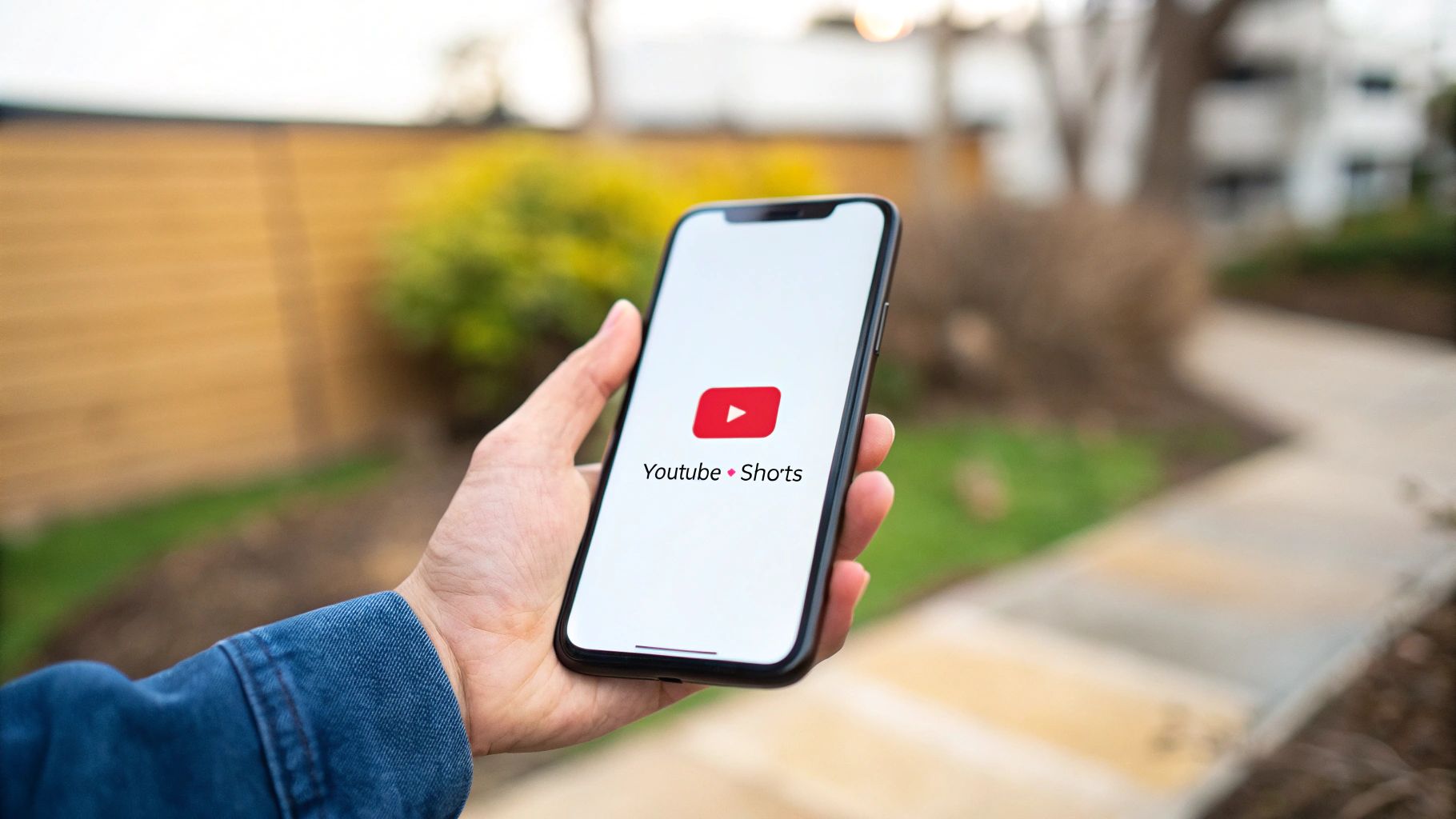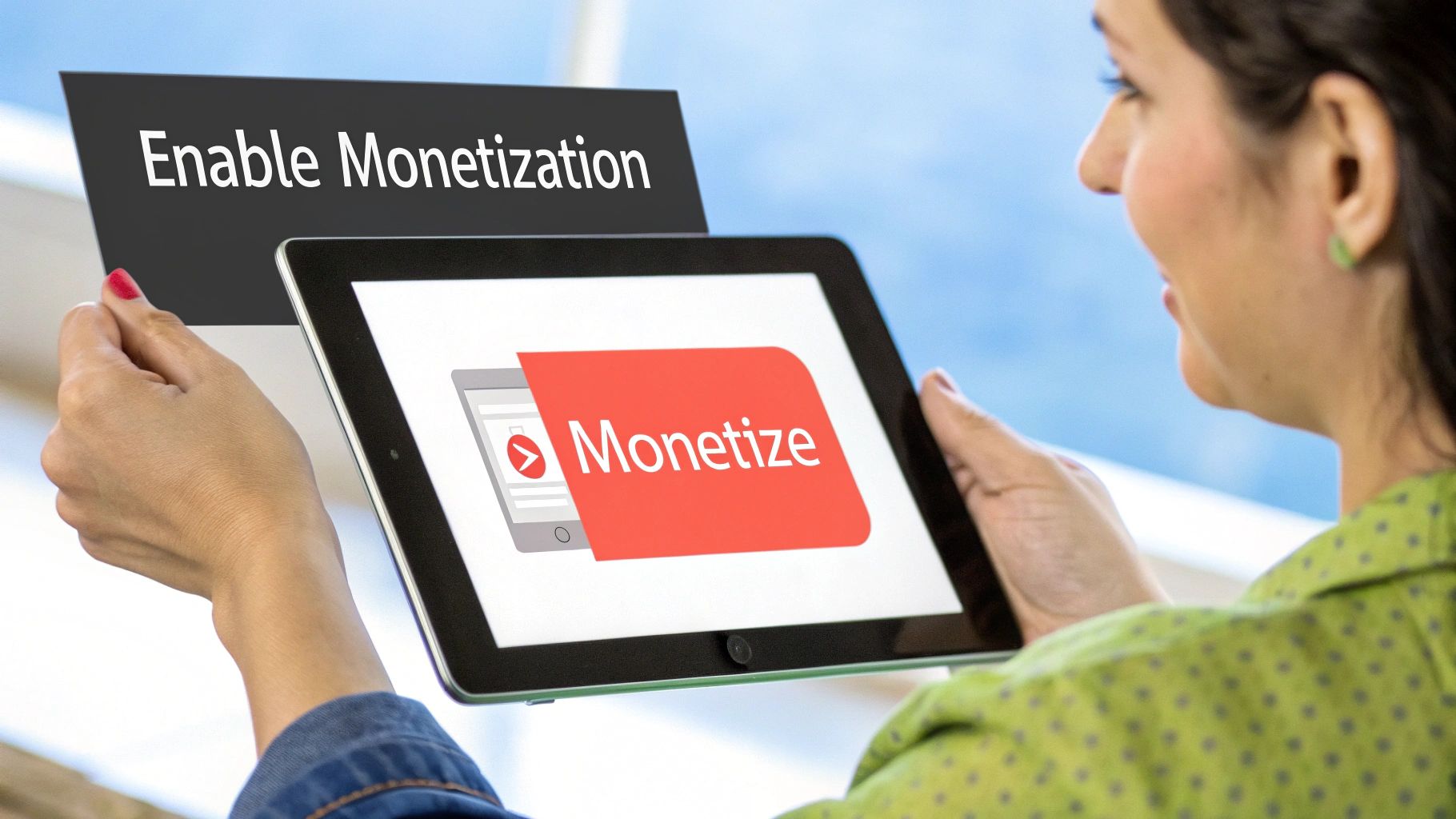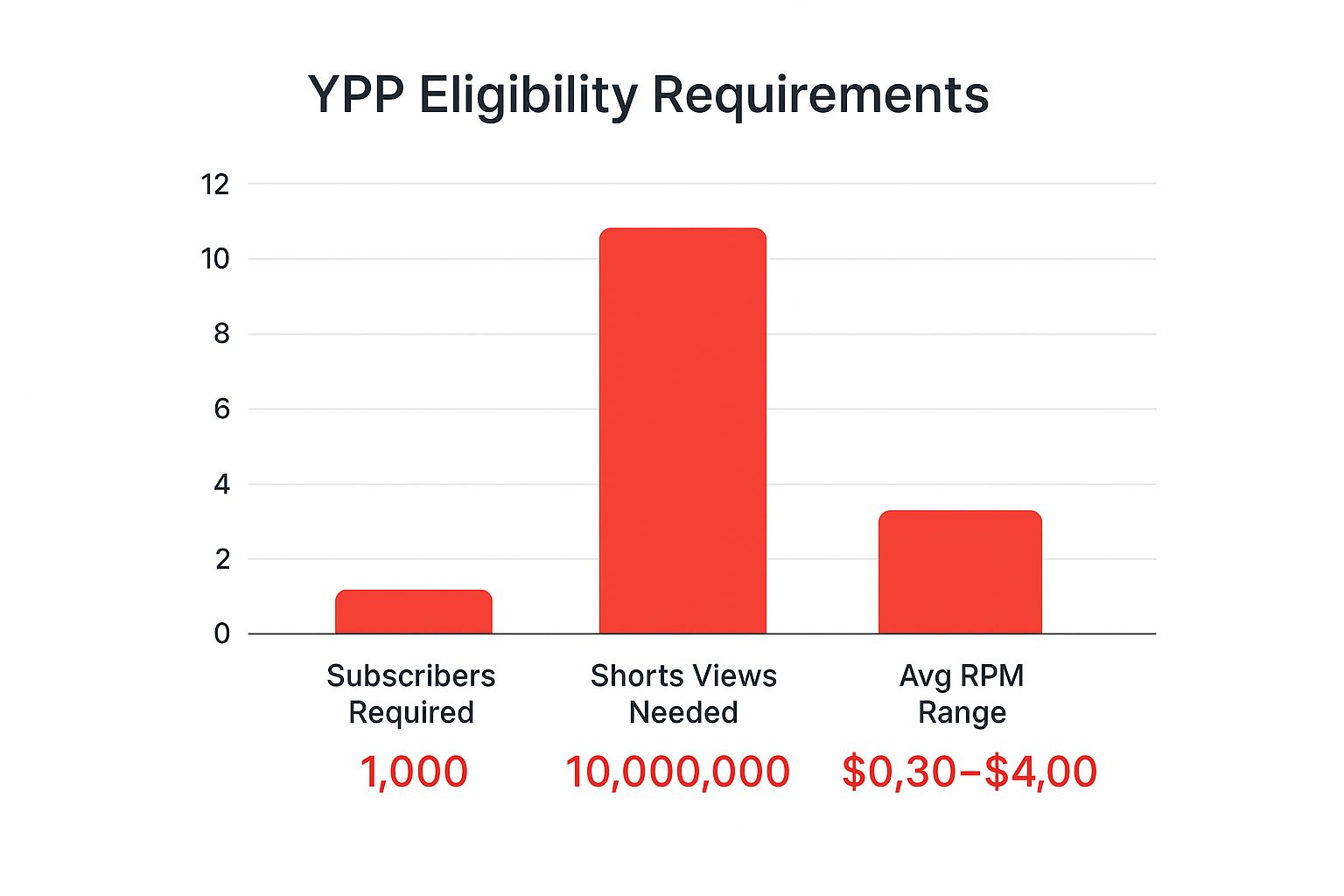Thinking about making money from those quick, vertical videos you're posting on YouTube? You're in the right place. The short answer is yes, you absolutely can monetize YouTube Shorts. What started as YouTube's answer to TikTok has quickly become a serious revenue stream for creators.
Let's break down exactly how you can turn your Shorts into cash.
Yes, You Can Monetize YouTube Shorts and Here's How

For a while, it felt like Shorts were just for exposure. Creators were racking up views but not seeing it translate to their bank accounts. That's all changed. YouTube has fully integrated Shorts into its monetization model, meaning your short-form content is now a legitimate way to earn.
The most direct route is through the YouTube Partner Program (YPP). Once you’re in, you get a cut of the ad revenue that plays between videos in the Shorts feed. It's the official, built-in way to get paid. But don't stop there. The smartest creators are mixing and matching several income sources, building a much more stable financial foundation for their channel.
Your Roadmap to Shorts Revenue
Getting paid for your Shorts isn't just a numbers game—it's about strategy. You need to know the different ways to earn and figure out which ones make sense for you and your audience. The good news? You've got options, ranging from YouTube's official programs to more independent, entrepreneurial methods.
The opportunity here is gigantic. As of mid-2025, YouTube Shorts are pulling in over 90 billion daily views worldwide. With that kind of massive audience, the potential for creators to connect, engage, and earn is bigger than ever.
To help you see the big picture, here’s a quick look at the main paths you can take to start earning from your YouTube Shorts.
YouTube Shorts Monetization Pathways at a Glance
This table breaks down the most common ways to make money with Shorts, what you'll need to get started, and who each method is best for.
| Monetization Method | Primary Requirement | Best For |
|---|---|---|
| Shorts Ad Revenue | YPP eligibility (1k subs & 10M views/90 days) | All creators with consistent viewership |
| Fan Funding (Super Thanks) | YPP eligibility (500 subs & 3M views/90 days) | Creators with a loyal and engaged community |
| Brand Deals & Sponsorships | An engaged, niche audience (any size) | Creators who can naturally integrate products |
| Affiliate Marketing | Trust with your audience | Review, tutorial, and recommendation channels |
| Selling Your Own Products | An established product or service | Entrepreneurs and creators with merchandise |
Think of this table as your starting point. Each of these paths offers a unique opportunity, and we’ll explore them in more detail. For an even more thorough breakdown, check out our complete revenue guide to make your Shorts as profitable as possible.
Getting into the YouTube Partner Program with Shorts
So, how do you actually start getting paid for your Shorts? The key is getting into the YouTube Partner Program (YPP). Think of it as your official backstage pass to earning money on the platform. It's YouTube's way of making sure channels are established and play by the rules before they can start sharing in ad revenue.
For a long time, the only way in was through long-form videos. But YouTube realized that building a massive audience with Shorts is a completely different ballgame. So, they created a specific path just for Shorts creators, which is fantastic news if that's your focus.
To get invited into the YPP, you need to hit a couple of key milestones. These aren't just random numbers; they prove to YouTube that you've built a real, engaged audience that advertisers would be interested in reaching.
The Two Big Goals for Monetization
To unlock ad revenue, your channel needs to hit two specific targets. They're designed to be a stretch, but totally achievable if you're consistently putting out great content.
You have to meet both of these requirements:
- 1,000 Subscribers: This is your foundation. It shows you’ve built a core community that genuinely wants to see what you post next.
- 10 Million valid public Shorts views in the last 90 days: This is the big one. It proves your content can go viral and capture massive attention in the Shorts feed.
That 90-day window is really important. YouTube is constantly looking at your performance over the last three months, so you need to keep the momentum going. It rewards creators who are active now.
Key Takeaway: You don't have to do it all! You can qualify with 1,000 subscribers and 10 million Shorts views OR the traditional way with 1,000 subscribers and 4,000 watch hours on long-form videos. You only need to meet one set of criteria.
This flexibility is huge. It lets you chase monetization using the strategy that works best for you. Whether you're all-in on Shorts, a long-form video essayist, or a mix of both, there's a path for you. If you want to explore these paths in more detail, check out our comprehensive YouTube monetization requirements guide.
How to Track Your Progress and Apply
Feeling a little intimidated by those numbers? Don't be. YouTube makes it super easy to see exactly where you stand.
Here’s how to check your progress:
- Log in to YouTube Studio.
- Click on the "Earn" tab in the menu on the left.
- You'll see a dashboard with clear progress bars tracking your subscribers and your 90-day Shorts views.
Once you hit both of your goals, a big blue "Apply" button will light up right on that page. From there, you'll review the program terms, connect a Google AdSense account for payments, and then wait for YouTube to review your channel. They're basically checking to make sure your content follows all their monetization and community rules.
This clear-cut process is a massive win for creators. In fact, some have managed to grow their channels up to 20% faster just by focusing on Shorts. Once you're in the YPP, you'll start earning from the Shorts ad revenue pool, where creators get 45% of the revenue from ads shown between Shorts in the feed. This model proves that if you can grab eyeballs, you can definitely make money with YouTube Shorts.
How YouTube Calculates Your Shorts Ad Revenue

Alright, let's break down how you actually get paid for your Shorts. It can feel a little confusing at first because it’s not like traditional YouTube videos where an ad runs directly on your content.
Think of Shorts revenue like a giant monthly pool party for all monetized creators. It's a collective model, and figuring out your final payout involves a few steps. We'll walk through exactly how YouTube takes those views and turns them into cash in your pocket.
Step 1: The Ad Revenue Pool
First things first, YouTube gathers up all the money made from the ads people see in the Shorts feed. These are the ads that pop up as you're swiping from one Short to the next. All that revenue gets collected into one big pot for the month.
This isn't about one specific ad on your video; it’s the combined value of every ad shown across the entire Shorts platform.
Step 2: Paying for the Music
Before any money gets to creators, YouTube has to pay the piper—or in this case, the music industry. A chunk of that big ad revenue pool is used to cover the costs of music licensing.
This is actually a good thing. It’s what lets you use popular, trending songs in your Shorts without getting hit with a copyright claim. The downside is that it reduces the total amount of money left over for creators.
How much gets taken out depends on whether you used music:
- If your Short has no music, all the revenue it helps generate goes straight into the "Creator Pool."
- If you use one song, that revenue gets split. Part of it goes to the music licensors, and the rest goes into the Creator Pool.
- If you use two songs (for example, with a remix), even more goes to the licensors.
This system makes sure artists get paid for their work while you still get a path to monetize YouTube Shorts that use their tracks.
Step 3: Calculating Your Share of the Creator Pool
Once the music licenses are paid, what's left is called the Creator Pool. This is the total pie that will be divided among every single monetized Shorts creator that month. How big of a slice you get depends entirely on your performance.
YouTube calculates your portion based on the views your Shorts got compared to the total views of all monetized Shorts. So, if your channel got 1% of all monetized Shorts views in your country, you get 1% of the Creator Pool.
It’s pretty simple, really. The more views you rack up, the bigger your piece of the pie.
Step 4: Your Final Payout
Now for the last step—what you actually take home. Of the money allocated to you from the Creator Pool, you keep 45%. YouTube keeps the remaining 55%.
This 45/55 split is the standard revenue share for the Shorts program. Yes, it's a bit lower than the 55% you get for long-form videos, but it accounts for the different way Shorts work, especially that platform-wide music licensing deal.
So, let's say your share of the Creator Pool for the month comes out to $200. Your final payment would be $90 (which is 45% of $200). It’s a clear-cut system once you understand how all the parts work together.
Exploring Monetization Beyond Ad Revenue

Getting into the YouTube Partner Program is a huge win, no doubt about it. But if you stop there and only rely on ad revenue, you're leaving a lot of money on the table. Think of it this way: ad revenue is just one branch on a much larger tree of potential income.
Smart creators know that Shorts aren't just 60-second videos; they're powerful marketing tools. They use their short-form content to open doors to several different income streams. This creates a much more stable business that isn't at the mercy of fluctuating ad rates. Let's dig into a few of the best ways to earn money from your Shorts that go way beyond the ad-share pool.
The Power of Affiliate Marketing
Affiliate marketing is a pretty simple deal. You talk about a product or service you like, and if someone buys it using your special link, you get a cut of the sale. Shorts are the perfect place for this because you can show off products you genuinely use in a quick, authentic, and convincing way.
For instance, if you’re a gaming creator, you could whip up a 30-second Short showing off a new gaming mouse. A quick look at its features, your genuine reaction, and boom—you've got compelling content. Then, you just drop your affiliate link in a pinned comment or the video's description.
This strategy works in almost any niche you can think of:
- Beauty: A super-fast tutorial featuring a specific eyeshadow palette.
- Tech: An unboxing and first-impressions clip of a new phone or gadget.
- Fitness: A quick demonstration of a useful piece of home workout gear.
Learning how to add clickable links into YouTube videos is a critical skill here. Just remember the golden rule: be honest with your audience and only push products you truly believe in.
Landing Brand Deals and Sponsorships
Sponsorships are the next level. This is where brands pay you directly to feature them in your content, and for many big creators, it's their number one source of income. You don't need a massive subscriber count to get started, either.
Brands are often looking for creators with smaller but highly engaged audiences.
A brand might much rather work with a creator who has 10,000 die-hard fans of a specific hobby than a channel with 100,000 casual viewers. Why? That smaller, focused audience is way more likely to be interested in what they're selling.
To start attracting brand deals, you need to present your channel professionally. Put together a media kit—a simple document showing your channel's stats, audience demographics, and engagement rates. Don't be afraid to reach out to brands that feel like a natural fit for your content and show them exactly how your Shorts can connect them with the right people.
Selling Your Own Stuff with YouTube Shopping
What if you want to be the brand? YouTube Shopping is an incredible feature that lets you tag and sell your own products right from your Shorts. When someone's watching, a little shopping bag icon pops up, letting them browse and buy your merch without ever leaving the YouTube app.
This is a huge opportunity for creators with an entrepreneurial streak. You can use your Shorts to:
- Launch new merch: Create a fun, high-energy Short to announce your latest t-shirt or hat design.
- Promote digital products: Selling an e-book or a course? Share a killer tip from it in a Short to give viewers a taste of what they could get.
- Showcase physical products: If you run an online store, film some behind-the-scenes Shorts of you making or packing orders.
This direct-to-consumer approach gives you total control over your brand, products, and profit margins. You're essentially turning your Shorts feed into a storefront that’s open 24/7, making it an essential piece of your monetization puzzle.
7 Strategies to Maximize Your Shorts Earnings
https://www.youtube.com/embed/pwe-xW8-rHg
Getting approved for the YouTube Partner Program is a huge milestone, but it's really just the starting line. Now, the real work begins: turning those views into meaningful income.
Think of it this way: getting monetized is like opening a shop. Now you have to figure out how to get the right customers in the door and encourage them to buy. Two channels with the same number of views can earn vastly different amounts. The secret lies in a few key strategies that can transform your Shorts from a fun side project into a serious revenue generator. Let's break down how to do it.
1. Target High-Value Audiences
This is probably the single most important lesson for any creator focused on revenue: not all views are created equal. The country your viewer is watching from has a massive impact on how much you earn. This is measured by RPM, or revenue per mille, which is your income per 1,000 views.
Why the difference? Advertisers in wealthier countries simply pay more to reach consumers. That means a view from someone in the United States is worth a lot more than a view from someone in a developing market.
For example, recent data shows a US-based view might earn an RPM of around $0.328, while a view from India could be as low as $0.008. That's a huge difference! This doesn't mean you should ignore massive audiences in lower-RPM countries, but it does mean that creating content that also appeals to high-RPM regions can dramatically increase your earnings without needing millions of extra views.
Comparison of YouTube Shorts RPM by Country
To see just how much RPM can change from one country to another, take a look at the table below. It shows the estimated revenue per 1,000 Shorts views in different markets.
| Country | Estimated Shorts RPM (USD) |
|---|---|
| United States | $0.328 |
| Switzerland | $0.205 |
| Australia | $0.193 |
| South Korea | $0.185 |
| United Kingdom | $0.166 |
| Mexico | $0.040 |
| Philippines | $0.023 |
| Indonesia | $0.012 |
| India | $0.008 |
As you can see, the gap between high-value markets like the US and Australia and high-volume markets like India and Indonesia is significant. A smart strategy often involves creating content with broad appeal to capture both.
2. Master Your Content and Posting Strategy
Beyond geography, the content you create and how often you post it are the biggest levers you can pull. This is where consistency and strategic thinking become your best friends.
A regular posting schedule does wonders for the YouTube algorithm. It signals that your channel is active and reliable, which helps keep your content in front of viewers. Whether you post once a day or three times, find a rhythm you can maintain. To make this easier, especially if you're experimenting with different frequencies, YouTube scheduling tools can be a lifesaver.
Another key is to constantly analyze what's working and what isn't.
- Find Your Viral Formula: Dive into your YouTube Studio analytics. Look at your best-performing Shorts and ask why they took off. Was it the hook in the first three seconds? The topic? The audio choice?
- Double Down on What Works: When you find a format or subject that your audience loves, make more of it! This doesn't mean just copying your old videos, but rather finding fresh angles on a winning theme.
- Use Trending Audio Smartly: Jumping on a trend can give you a huge visibility boost. While using popular licensed music will slightly lower your share of the revenue for that specific video, the explosion in views and subscribers it can bring often more than makes up for the small dip.
Pro Tip: Don't be afraid to experiment. The Shorts algorithm rewards freshness. Test different video lengths, editing styles, and calls-to-action. Every Short you post is a new piece of data that makes your next one even better.
Ultimately, maximizing your Shorts earnings is about being a smart, data-informed creator. It means looking past the simple view count and understanding the mechanics of what drives revenue. By targeting valuable audiences, sticking to a smart posting schedule, and constantly learning from your analytics, you can turn your channel into a much more powerful income stream.
Common Questions About Shorts Monetization
Even with all the rules laid out, you're probably still juggling a few questions about how YouTube Shorts monetization really works. That’s completely normal. The system has its own quirks, so let's clear up some of the most common points of confusion.
Think of this as a quick FAQ session to help you move forward with confidence.
How Much Does YouTube Actually Pay for Shorts Views?
This is the big one, isn't it? Everyone wants to know what a million views are actually worth. The honest answer is: it varies. A lot. There's no flat rate per view because your earnings, or RPM (Revenue Per Mille), depend heavily on who is watching your content.
On average, creators report an RPM anywhere from $0.01 to $0.06. But that's just a ballpark figure. The biggest factor is your audience's location. A view from the United States or the UK, where advertisers spend more money, is worth significantly more than a view from a region with a smaller ad market.
The takeaway here is that it's not just about the number of views, but the quality of those views. If you can create content that resonates with audiences in high-RPM countries, you’ll see a real difference in your earnings.
This graphic gives you a nice visual breakdown of the milestones and what you might expect to earn.
 As you can see, the targets are specific, but hitting them unlocks a solid earning opportunity.
As you can see, the targets are specific, but hitting them unlocks a solid earning opportunity.
Do I Need to Reapply if I Am Already a YouTube Partner?
Got some good news for you! If you’re already in the YouTube Partner Program (YPP) from your long-form videos, you don't have to go through the whole application process again. You're already in the club.
You do have one tiny step to take, though.
- Head over to YouTube Studio.
- Click on the "Earn" tab in the menu on the left.
- Look for the "Shorts Monetization Module" and click to accept the terms.
That’s it. Once you agree, your eligible Shorts will automatically start earning ad revenue from the feed. It’s a super simple process for existing partners.
Can I Use Popular Music and Still Get Paid?
Yes, you absolutely can, but there's a catch. YouTube has a smart system that lets you use trending tracks from its massive audio library, but the original artists need to get paid, too.
Here’s how the revenue share works:
- If you use one licensed song, the money from that Short is split between you and the music publisher.
- If you use two licensed songs, the revenue is split three ways: you and both music publishers.
So, while using a trending song might get you a ton of views, your slice of the pie will be smaller for that particular video. It's a trade-off. However, using music from outside YouTube’s library is a bad idea—that will almost certainly lead to a copyright claim and no money at all. For a deeper dive, check out our guide on how creators earn revenue from monetized Shorts.
Why Did My Shorts Views Suddenly Drop?
This one freaks a lot of creators out. Your Short is getting thousands of views an hour, you're on top of the world, and then... crickets. The views just stop.
Don't panic! This is actually a normal part of how the Shorts algorithm works. The system is built to blast new content out to a wide audience to see how it performs. After a while, that initial boost ends as the algorithm moves on to test other new videos. A sudden drop doesn't mean you're in trouble; it just means the promotional wave for that specific video is over.
Because your income is tied to views, this will naturally cause your earnings to dip. The best way to deal with this is to stay consistent. Keep creating great content, figure out what made your hit videos successful, and focus on building a steady stream of new Shorts to keep the views—and the income—flowing.








